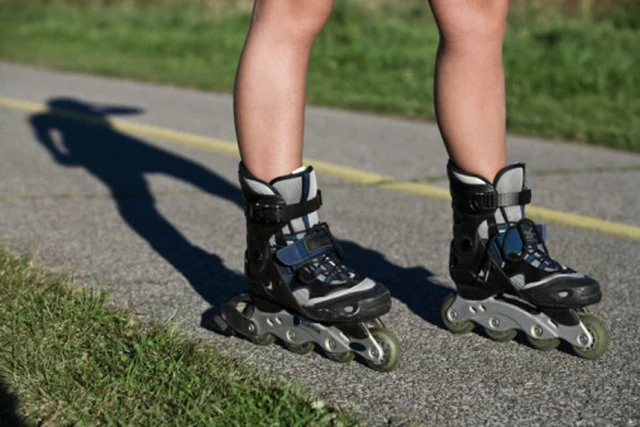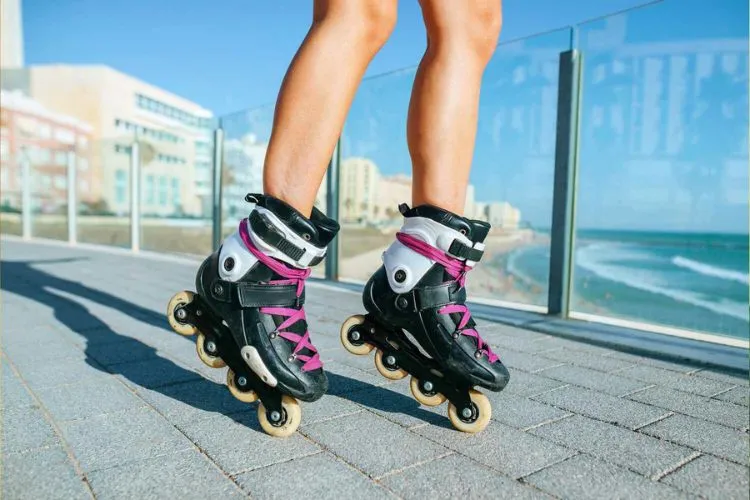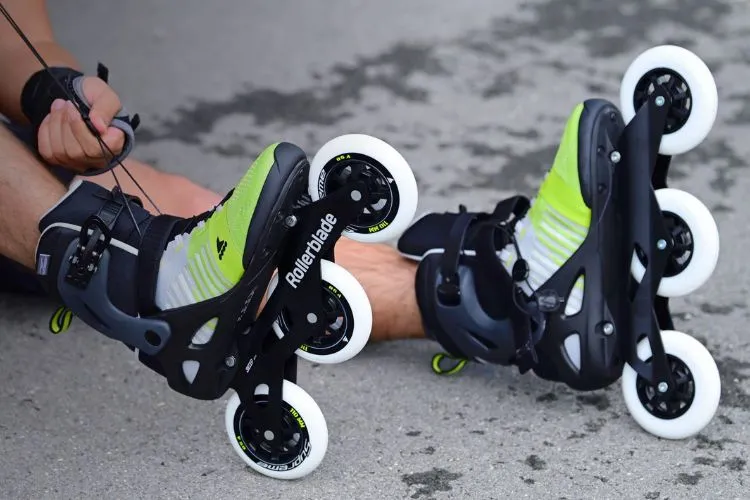Inline skating has become a popular fitness activity enjoyed by many. It offers a fresh twist on regular workouts and brings an element of fun and adventure to staying fit.
The central question for many is, does inline skating help you lose weight? This article aims to answer that question.

Understanding Inline Skating
Inline skating refers to a recreational activity where people use skates with a single, straight line of wheels. The styles of inline skating vary, from casual gliding to intense roller hockey. Each style involves a certain physical effort, which contributes differently to calories burned.
Inline Skating and Calories
During inline skating, the body burns calories. According to a study by the National Institutes of Health, a person weighing 160 pounds burns roughly 913 calories per hour of inline skating. That’s a substantial figure compared to other affordable exercises.

To illustrate, walking or yoga would burn around 300-500 calories within the same duration. Of course, variables like intensity, body weight, and age affect the exact number of calories burned. Nonetheless, it’s clear that inline skating is a great choice to boost calorie burn.
Does Inline Skating Help You Lose Weight?
Besides calorie burning, inline skating engages multiple muscle groups in the body. The activity requires you to maintain your balance, which activates the core muscles. In addition, it involves a lot of leg work. It tones quads, hamstrings, and calves, turning them into lean, high-performance muscle groups.
Building muscle comes with its weight loss benefits. Muscles are metabolically active tissue. They burn calories even at rest! So, inline skaters aren’t just burning calories during their workout — the muscle they build helps to burn calories all day long.
Consistency and Weight Loss
Like all forms of exercise, consistency is key with inline skating. The more often you do it, the faster you’ll lose weight. Some skaters have shared personal stories on forums like Reddit, describing how they’ve managed to lose significant weight by skating frequently.
Diet and Inline Skating
Of course, exercise alone can’t guarantee weight loss. Diet plays a crucial role. Many fitness enthusiasts cite the 80/20 rule, which stipulates that weight loss depends 80% on diet and 20% on exercise. Ensure that your diet is rich in protein, low in saturated fat, and loaded with fruits and vegetables while you enjoy inline skating.
Tracking Progress
A useful way to appreciate the weight loss benefits of inline skating is by tracking progress. Methods could include checking body weight, doing body composition measurements, or merely noticing how differently your clothes fit. Keeping a journal of this can be helpful.
Tips to Maximize Weight Loss with Inline Skating
There are several tips to optimize the weight loss benefits of inline skating. To start with, incorporate interval training into your skating. This approach involves doing periods of high-intensity skating followed by periods of lower intensity.
It’s a tested way of burning calories. Suggested skating routines range from short, high-energy sessions to longer, relaxed ones, depending on individual fitness levels.
Safety Measures for Inline Skaters
One important aspect that should not be overlooked is safety. Always use proper safety gear, such as helmets and knee pads, while inline skating. This will minimize the risk of injury and allow you to perform at your best, which in turn helps enhance your weight loss.
You may also find useful: Inline Skates vs Quad Skates: Choosing the Best Ride for You
Benefits of Inline Skating Beyond Weight Loss
Inline skating is more than just an effective weight loss activity; it offers a myriad of additional health benefits, which contribute to both physical and mental well-being. One of the key physical benefits is the improvement in balance and coordination.
The activity necessitates maintaining stability on wheels, which strengthens the core and leg muscles, essential for balance. This enhanced coordination extends beyond skating into daily activities, potentially reducing the risk of falls and injuries.

Cardiovascular health sees significant gains from regular inline skating. It’s a heart-pumping workout that increases the heart rate to levels comparable to running, but often with a lower perception of exertion. This vigorous aerobic exercise strengthens the heart, increases lung capacity, and can help lower blood pressure and bad cholesterol levels, contributing to overall heart health.
Beyond the physical, inline skating has notable mental wellness benefits. It acts as a stress reliever, offering an escape from daily pressures and a chance to clear the mind. The exercise involved releases endorphins, which are natural mood lifters, helping to combat anxiety and depression. Furthermore, being an outdoor activity, it provides essential exposure to sunlight, which can boost vitamin D levels and improve mood.
Moreover, the focus and attention required while skating can enhance cognitive functions, encouraging sharper thinking and concentration skills. The social aspect of skating, whether through joining clubs or participating in group events, fosters community connections and friendships, contributing positively to emotional well-being.
Inline Skating for Beginners: Getting Started
For those new to the world of inline skating, starting can be both exciting and daunting. Here’s a concise guide to help beginners ease into this enjoyable sport safely and confidently.

- Choose the Right Skates: Start with selecting a pair of skates that fit well. Your skates should be snug but not too tight, with enough room to wiggle your toes. For beginners, opting for skates with a brake attached is advisable until you become proficient in stopping techniques.
- Safety First: Safety gear is non-negotiable. Always wear a helmet, wrist guards, elbow pads, and knee pads. These will protect you from injuries if you fall, making your learning process safer and more confidence-inspiring.
- Learn the Basics: Before hitting the trails, spend some time learning the basic movements and techniques—starting, stopping, and turning. Practice in a smooth, flat area with little to no traffic, like a parking lot or a quiet park path.
- Master the Fall: Falling is part of the learning process. Learning how to fall correctly can minimize injuries. Practice falling on grass, aiming to land on the side of your body while keeping your wrists and elbows protected with your gear.
- Build Balance and Strength: Inline skating requires a good sense of balance. Off-skates exercises like squats, lunges, and balance training can help build the necessary leg and core strength that will make your skating experience smoother.
- Take It Slow: Progress at your own pace. Start with short distances on flat, smooth surfaces. As your confidence and skills grow, you can explore longer distances and more challenging terrains.
- Connect with the Community: Joining a local skating group or taking classes can provide valuable support, motivation, and guidance from more experienced skaters.
Remember, inline skating is about having fun and enjoying the outdoors. Be patient with yourself, practice regularly, and celebrate your progress, no matter how small.
Choosing Your Skates: A Brief Guide
When choosing inline skates, personal comfort, budget, and level of expertise are paramount. Beginners should seek skates that offer good ankle support and are specifically designed for new skaters. These typically have a comfortable fit, a brake, and are not overly fast, making them easier to control.
Intermediate and advanced skaters may opt for more specialized skates. Fitness skates are great for exercise and longer rides, while speed skates with larger wheels are suited for experienced skaters looking for speed and efficiency. Aggressive skates are reinforced for jumps and tricks, appropriate for those interested in stunts.
Conclusion
Inline skating is a fun, effective way to help lose weight. It burns calories, involves multiple muscle groups, and can be done consistently. Paired with a balanced diet, it helps create a calorie deficit conducive to weight loss. Keep safety in mind, lace up your skates, and enjoy the thrilling journey towards fitness and weight loss. Happy skating!

Matthew James is a passionate skater who wanted to create a platform to share his love for skating with others. With a vision to create a vibrant community of skaters, he aims to provide a space where skaters of all levels can connect, learn, and grow together.
